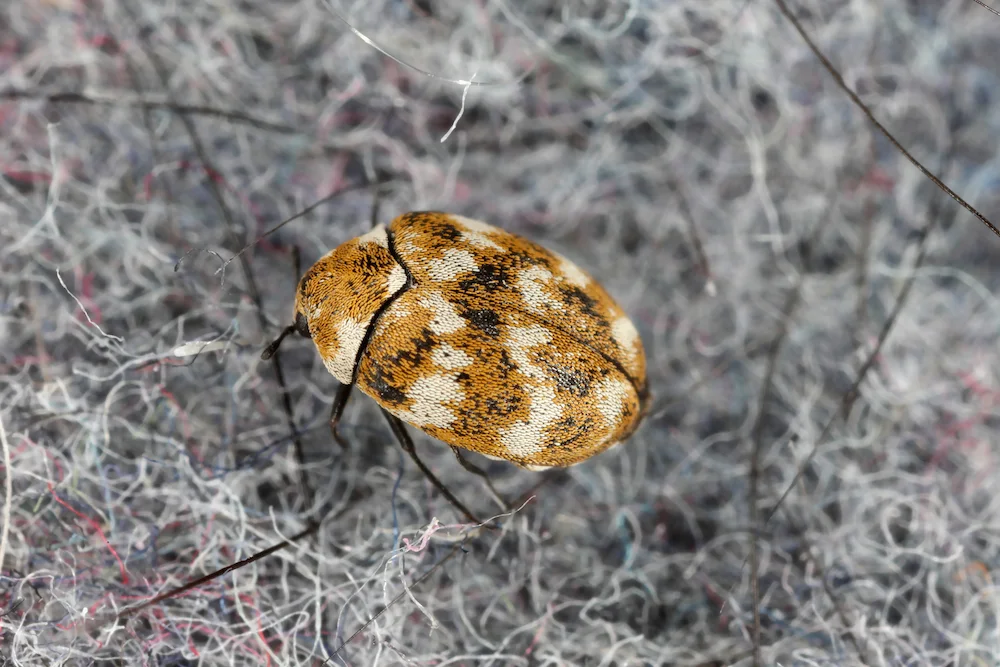Summary: Carpet beetles are sneaky pests, which makes their destruction even more frustrating for homeowners. This blog describes the lifecycles and habits of carpet beetles, including their appearance, habitats, and diets. Pointe Pest Control provides thorough, year-round pest control for the sneakiest of pests.
Carpet beetles aren’t the most exciting pests, but they’ve sure made a name for themselves! By that, we mean that one of their favorite foods and habitats is literally in their name. Carpet beetles usually aren’t found until they’ve already fed on organic fabrics and carpets. This is pretty frustrating if you don’t like random tiny holes in your clothes — and who would?
The trick to preventing carpet beetle damage is to stay one step ahead of the pests. This is possible when you know their habits, then use these preferences against them. With that in mind, let’s dive into the muted world of carpet beetles and learn why their diets are so harmful to our household items!
Beetle Basics
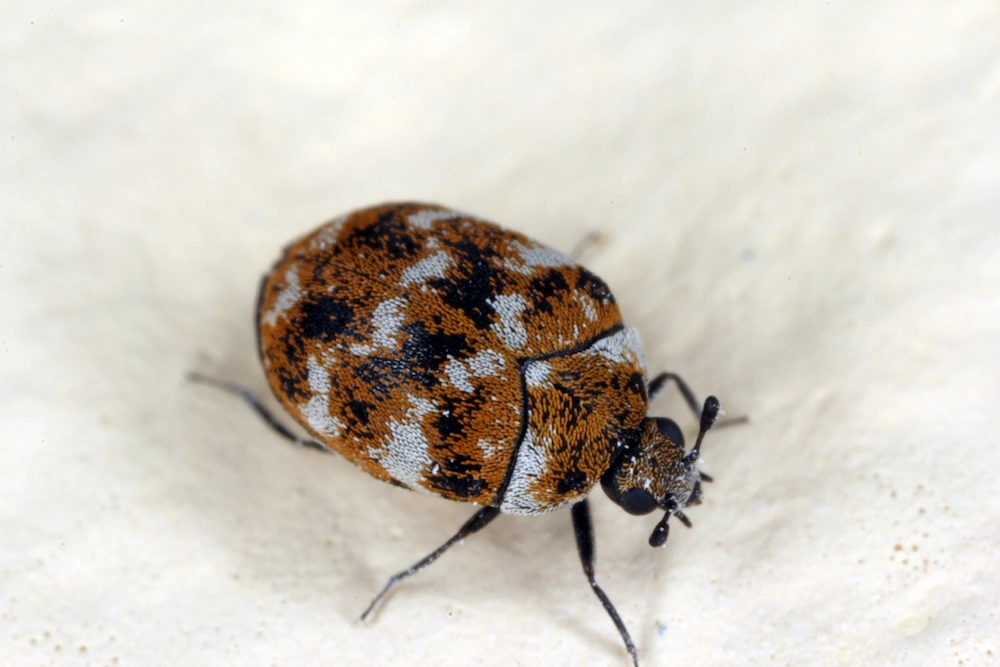
The life cycle of carpet beetles can take anywhere from a couple months to several years to complete, based on their environment. This means that an infestation can grow for years before the adult beetles are even ready to fly the coop (figuratively speaking, of course).
As with most insects, carpet beetles are most active in summer because of the high temperatures. They lay 50 to 100 eggs on or near a food source to give their offspring the best chance at survival. The adults only live for 4 to 6 weeks, so they don’t have long to reproduce.
As adults, carpet beetles are up to 1/8 of an inch long. They’re either black or covered in a mottled brown-and-white pattern. They also have wings and can fly short distances. Carpet beetle larvae are brown and up to 1/4 of an inch long. They’re covered in dense hairs and look like furry worms while they slowly crawl to their next destination.
How Do They Invade?
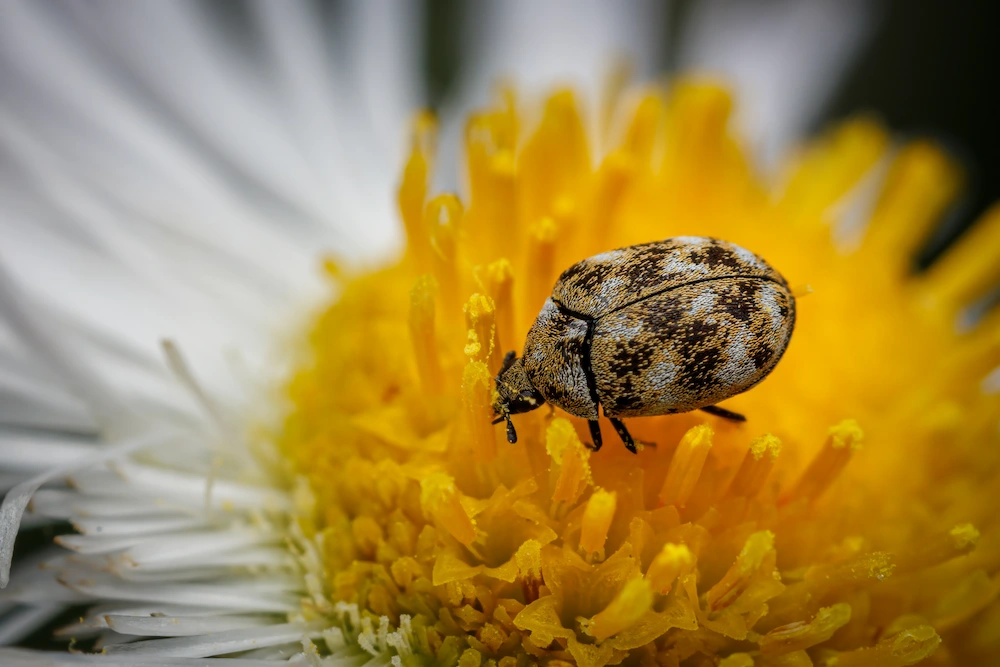
How do these tiny pests get inside our homes in the first place? After all, the larvae are resigned to slowly crawl everywhere, and the adults don’t fly long distances. The short answer is that carpet beetles are just another case of a pest where you often don’t know they’re here until it’s too late. Bed bugs, termites, and fleas fall under this category as well.
The two main ways that adult carpet beetles invade are through entry points and flowers. If there’s a gap in the siding or a hole in the window screen, a carpet beetle can simply squeeze through the opening. These beetles have a flower-based diet (more on this later), so it’s easy to accidentally bring in a carpet beetle on cut flowers if you’re not careful.
Their Favorite Habitats
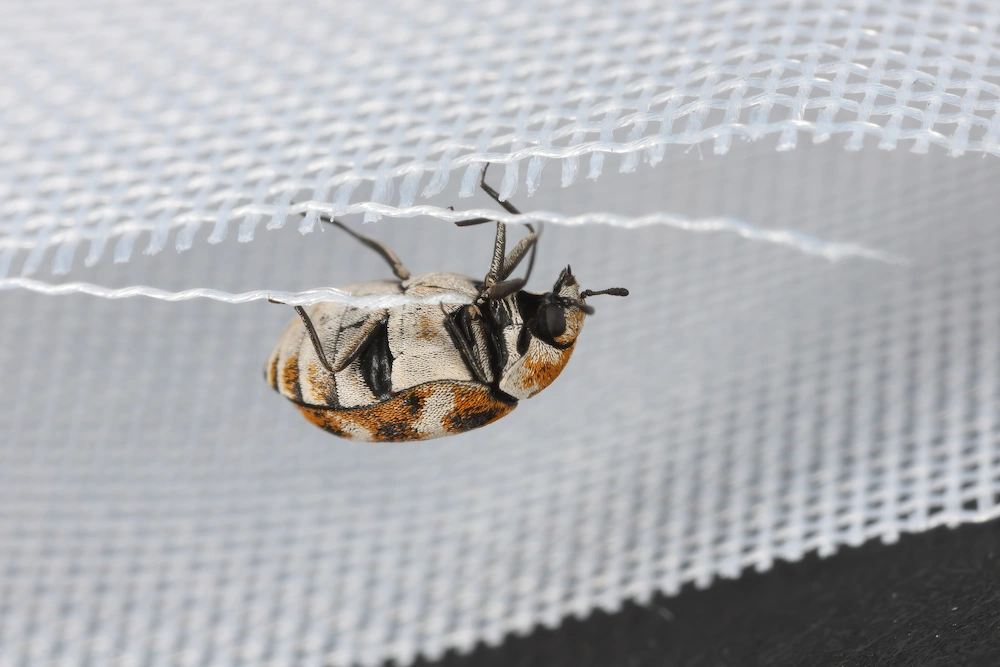
The difference between adult carpet beetles and beetle larvae is most obvious in their respective choice of habitat. Adult beetles love sunlight and want to be outside among the flowers. They start trying to make their escape from houses in the spring, so their busy season is coming up soon.
Conversely, larvae prefer to stay in isolated darkness at all times. They stay away from frequently-used items and instead opt for forgotten spaces. We often see the larvae in closets, chests, boxes, dirty air ducts, bird nests, and the underside of rugs. If there’s a pile of sweaters that sits untouched for months, carpet beetle larvae will be happy to stay for the long run.
Detrimental Diets

If you’re looking for a simple answer to the question of what carpet beetles eat, it’s keratin. This is a fibrous animal protein that is found in a huge variety of natural fabrics and organic products. Carpet beetles can only really digest keratin, so anything they eat needs to have a high concentration of the protein.
The most common food sources for carpet beetle larvae are:
- Felt
- Silk
- Animal skins
- Feathers
- Fur
- Wool
- Leather
- Hair
- Lint
- Insects
- Bird nests
- Piano felts and hammers (check your piano!)
As we mentioned earlier, adult carpet beetles have a different diet. They eat pollen and nectar, so they can be found mingling with bees in flower gardens. If they’re indoors, carpet beetles are usually seen on windows and windowsills in hopes of reaching the warm outdoors. In every life stage, the carpet beetle can go multiple days without food — which is bad news for us.
How To Prevent & Eliminate Carpet Beetles
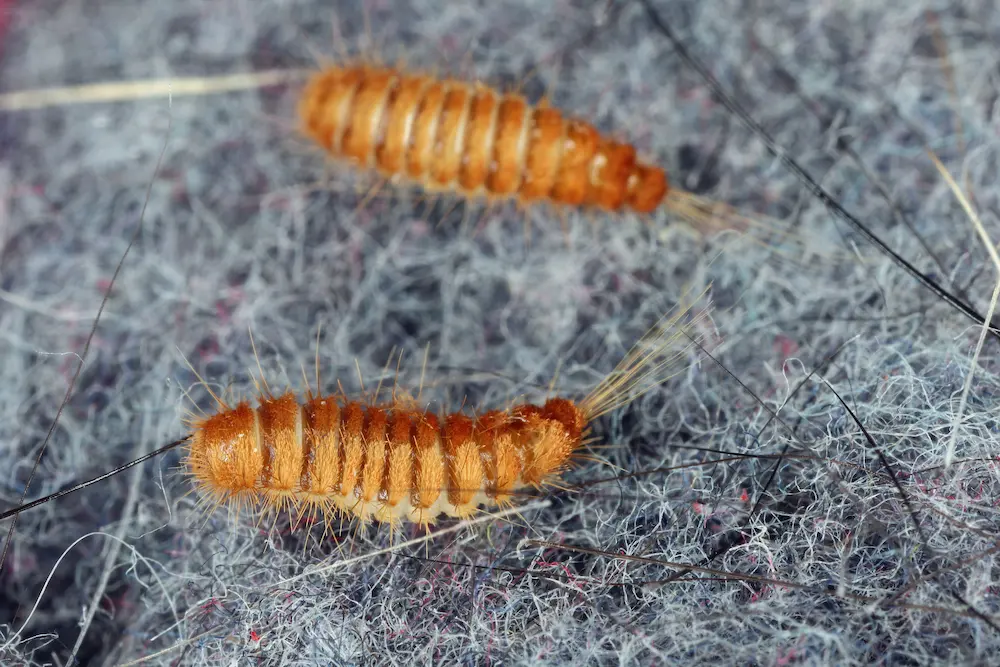
If you’re feeling squeamish about the idea of carpet beetles crawling in the dark corners of your home, don’t fret! It may be a small comfort to know that carpet beetles are largely harmless to people and animals. Some people experience a mild allergic reaction to the hairs of the larvae, but there has to be a lot of larvae around for a long period of time. If you start having mild allergy symptoms, it’s worth finding out if you have a carpet beetle invasion.
Many of the warning signs are similar to a clothes moth invasion since they essentially cause the same problems. Either way, it’s important to stay vigilant against these pests for the sake of your favorite fabric-based items.
The best ways to both prevent and eliminate carpet beetles are:
- Store Items in Good Containers — Instead of cardboard boxes, use lidded containers and zip-top plastic bags for long-term storage.
- Use Moth Balls (or similar tools) — Moth balls, lavender sachets, and other preventative items are also effective here. Just make sure they’re out of reach of pets and children!
- Vacuum Often — Vacuum your house (including the closets) at least once a week. Use the attachments to get the carpet under furniture and right next to the baseboards.
- Dry Clean Stored Items — Any clothing items that are stored more often than worn (Grandma’s fur coat, your suit, etc.) should be dry cleaned at least once a year.
- Use Sticky Traps — This is helpful if you believe you have an infestation. Place carpet beetle sticky traps in dark areas that are believed to be impacted, and check the traps daily.
- Seal Cracks — Inspect the exterior of the house often for any cracks and gaps. Seal these openings with waterproof caulk to keep carpet beetles (and other pests) out.
- Look for the Signs — Overall, keep an eye out for the signs of an invasion. These include small jagged holes in fabric-based items, shed beetle skins, and live or dead carpet beetles.
- Dispose of Infested Items — If you are unlucky enough to find carpet beetles crawling all over an article of clothing or bedding, we suggest cutting your losses and disposing of the item. Put it in a bag, tie up the bag, and throw the bag away in the outside garbage can. If you really want to save the item, wash it in hot water and dry clean it.
Expect The Best From Pointe!
Hidden pests can turn into major headaches for homeowners, especially when they cause more damage the longer that they’re left alone (looking at you, carpet beetles). The licensed technicians of Pointe Pest Control are committed to providing efficient pest solutions that eliminate pests and prevent future infestations.
We do not believe in a “one-size-fits-all” approach that uses general products on every area of pest activity. Instead, Pointe creates a customized treatment plan for every customer. This plan uses targeted treatments to solve the customer’s pest problems and prevent future invasions all in one service. Contact us for a free quote on our general pest control program and see the Pointe difference in your pest control!
Citations
Carpet beetles. (n.d.). United Pest Solutions. Retrieved February 27, 2025, from https://www.unitedpestsolutions.com/pest-id/beetles/carpet-beetles/
Choe, D.H. (2020, April). Carpet beetles. University of California Agriculture & Natural Resources. Available at https://ipm.ucanr.edu/PMG/PESTNOTES/pn7436.html (Accessed on February 27, 2025).
Kraft, S. & Pinto, L. (2023, November 2). Carpet beetles…not just in carpets. Pest Control Technology. Available at https://www.pctonline.com/news/carpet-beetles-not-just-in-carpets/ (Accessed on February 27, 2025).
Potter, M.F. (n.d.). Carpet beetles. University of Kentucky: Department of Entomology. Available at https://entomology.ca.uky.edu/ef601 (Accessed on February 27, 2025).

